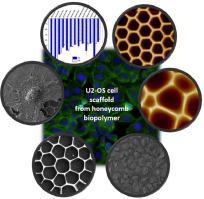Polymer Degradation and Stability ( IF 5.9 ) Pub Date : 2020-09-18 , DOI: 10.1016/j.polymdegradstab.2020.109370 Klára Neznalová , Dominik Fajstavr , Silvie Rimpelová , Nikola Slepičková Kasálková , Zdeňka Kolská , Václav Švorčík , Petr Slepička

|
The main aim of our work was to design a simple approach for preparation of a specific pattern with a honeycomb-like structure on a solid polymer substrate and to evaluate its cytocompatibility. We have chosen poly-(L-lactic) acid (PLLA) as a source material for formation of the honeycomb-like pattern and perfluorethylenepropylene (FEP) as underlying substrate material. The PLLA pattern formation was induced by improved phase separation with application of a dip-coating technique. Surface morphology, chemistry and wettability of the patterned structure were strongly affected by the initial pretreatment parameters of the FEP substrate, i.e., by the plasma power and exposure time. The pattern formation was unsuccessful without plasma pretreatment. Surface morphology of the PLLA pattern was studied by both of atomic force and scanning electron microscopies. Surface chemistry was analyzed by energy dispersive spectroscopy. The wettability and ability to change electrolyte flow, which might be important for cell-material interaction, were studied by goniometry and zeta-potential, respectively. Due to the morphology and roughness of the prepared pattern, human cells derived from osteosarcoma (U-2 OS) were chosen to evaluate the material cytocompatibility WST-1 assay. Moreover, morphology of cells growing on the honeycomb-like pattern was studied in detail by fluorescence and scanning electron microscopies. We have been able to determine such combination of substrate plasma pre-treatment and honeycomb-like pattern formation on the basis of different amount of target material (PLLA) that led to construction of an excellent scaffold for U-2 OS cell culture.
中文翻译:

血浆活化的FEP上的蜂窝图案聚L-乳酸作为细胞培养支架
我们工作的主要目的是设计一种简单的方法,以在固体聚合物基质上制备具有蜂窝状结构的特定图案,并评估其细胞相容性。我们选择聚(L-乳酸)(PLLA)作为形成蜂窝状图案的原料,并选择全氟乙烯丙烯(FEP)作为基础基材。通过使用浸涂技术改善相分离来诱导形成PLLA图案。FEP基板的初始预处理参数(即等离子功率和曝光时间)强烈影响图案化结构的表面形态,化学性质和润湿性。如果不进行等离子体预处理,则图案形成不会成功。通过原子力和扫描电子显微镜研究了PLLA图案的表面形态。表面化学通过能量色散光谱法分析。分别通过测角法和ζ电势研究了可能对电池材料相互作用至关重要的润湿性和改变电解质流的能力。由于所制备图案的形态和粗糙度,选择了来自骨肉瘤(U-2 OS)的人细胞来评估材料细胞相容性WST-1分析。此外,通过荧光和扫描电子显微镜详细研究了以蜂窝状图案生长的细胞的形态。


























 京公网安备 11010802027423号
京公网安备 11010802027423号